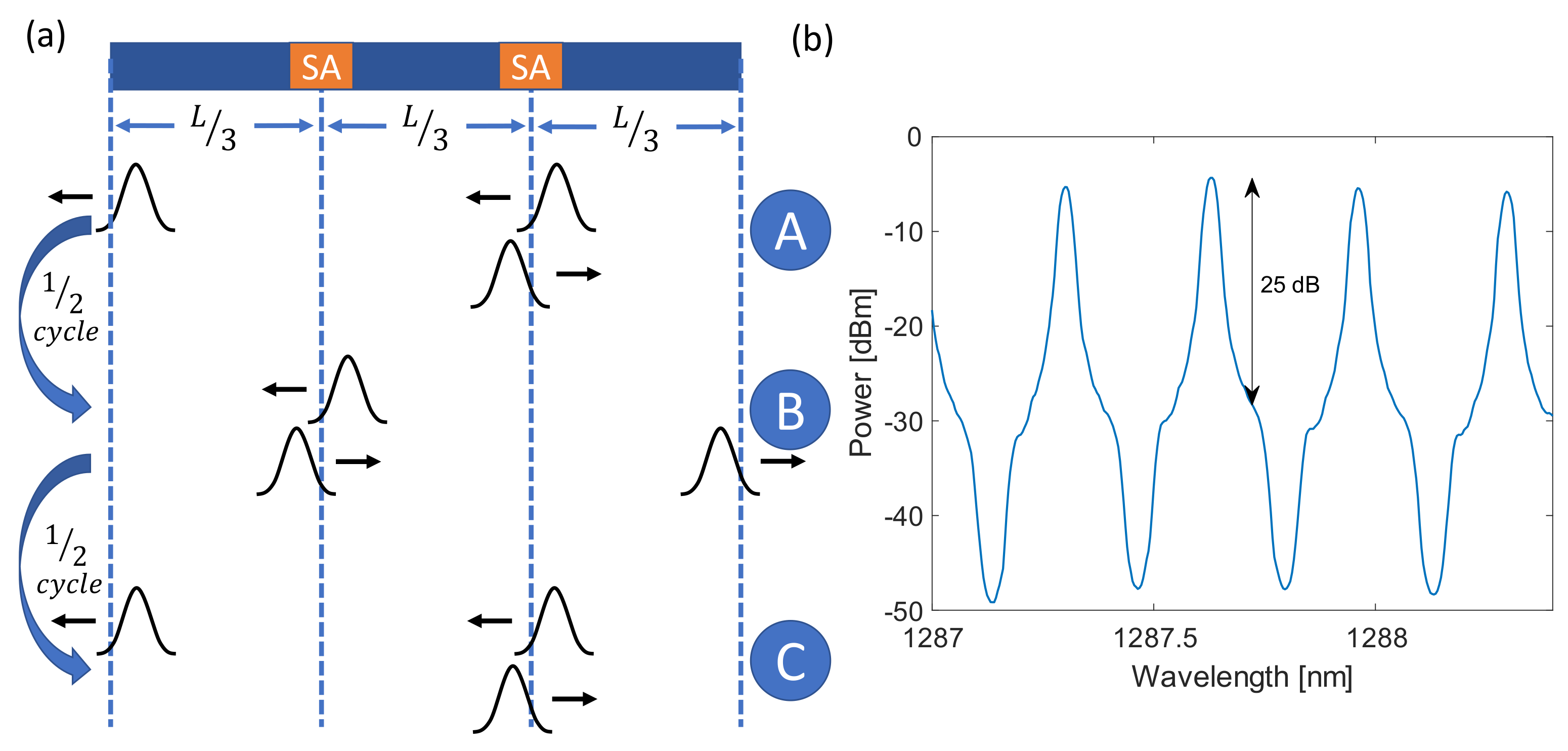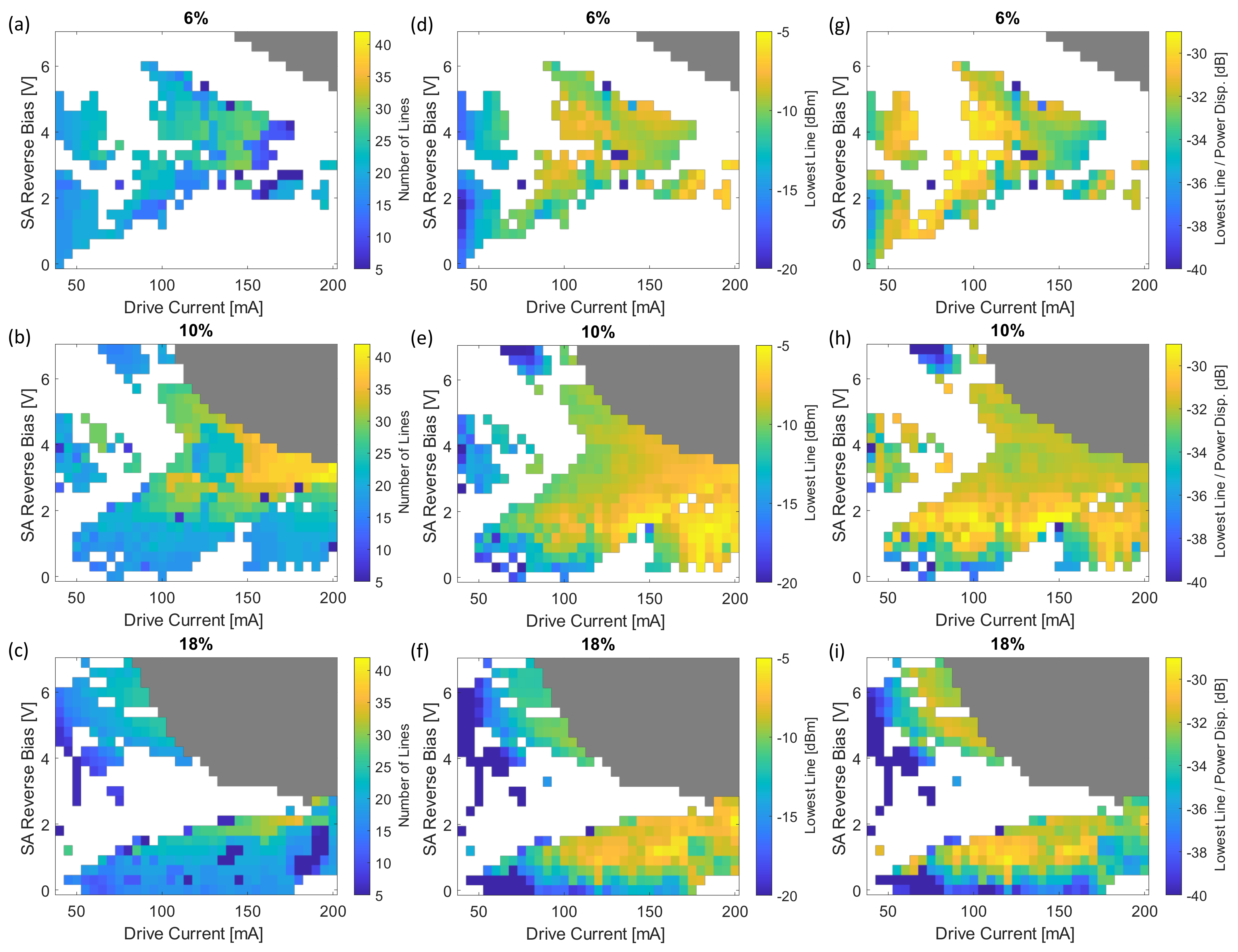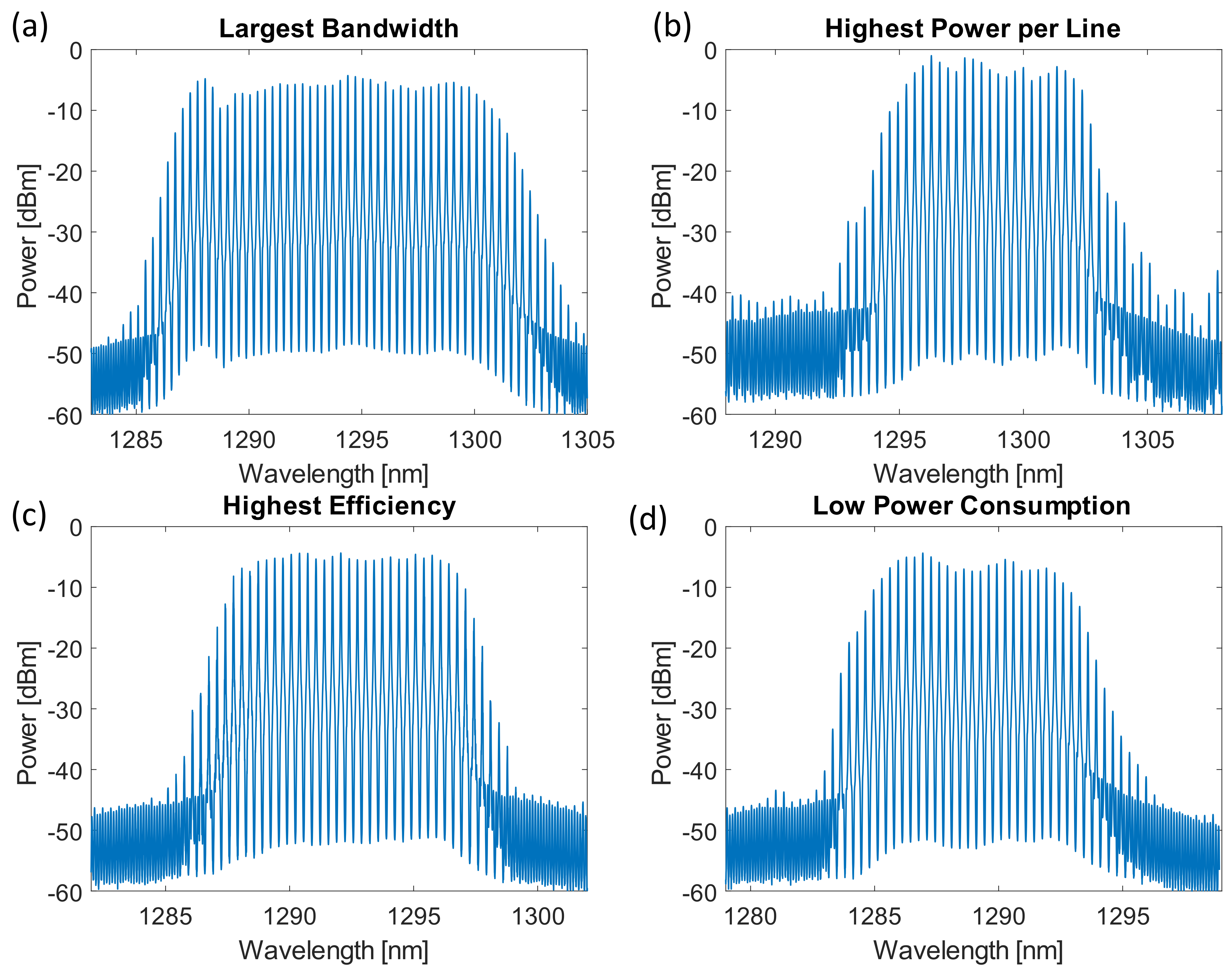High-Efficiency Quantum Dot Lasers as Comb Sources for DWDM Applications
Abstract
:1. Introduction
1.1. DFB Arrays
1.2. Nonlinear Optical Frequency Combs
1.3. Semiconductor MLLs
2. Device Design and Fabrication
3. Performance of CPMLLs
3.1. LIV Performance
3.2. Comb Bandwidth
3.3. Power per Line
3.4. Comb Efficiency
4. Conclusions
Author Contributions
Funding
Institutional Review Board Statement
Informed Consent Statement
Data Availability Statement
Acknowledgments
Conflicts of Interest
Abbreviations
| CPM | colliding pulse mode locking |
| CPMLL | colliding pulse mode locked laser |
| DEMUX | demultiplexer |
| DFB | Distributed Feedback Laser |
| DWDM | Dense Wavelength Division Multiplexing |
| GVD | Group-Velocity-Dispersion |
| IO | input-output |
| MLL | mode locked laser |
| MRM | micro-ring modulator |
| MUX | multiplexer |
| NOFC | nonlinear optical frequency comb |
| PoLL | power of the lowest line |
| QD | quantum dot |
| SA | saturable absorber |
| SMSR | side mode suppression ratio |
| WDM | Wavelength Division Multiplexing |
| WPE | wall plug efficiency |
References
- Cisco Visual Networking. The Zettabyte Era–Trends and Analysis. Cisco White Paper. 2018. Available online: https://www.cisco.com/c/en/us/index.html (accessed on 4 November 2021).
- Ghiasi, A. Large data centers interconnect bottlenecks. Opt. Express 2015, 23, 2085. [Google Scholar] [CrossRef] [PubMed]
- Cheng, Q.; Bahadori, M.; Glick, M.; Rumley, S.; Bergman, K. Recent advances in optical technologies for data centers: A review. Optica 2018, 5, 1354. [Google Scholar] [CrossRef]
- Margalit, N.; Xiang, C.; Bowers, S.M.; Bjorlin, A.; Blum, R.; Bowers, J.E. Perspective on the future of silicon photonics and electronics. Appl. Phys. Lett. 2021, 118, 220501. [Google Scholar] [CrossRef]
- Komljenovic, T.; Huang, D.; Pintus, P.; Tran, M.A.; Davenport, M.L.; Bowers, J.E. Photonic Integrated Circuits Using Heterogeneous Integration on Silicon. Proc. IEEE 2018, 106, 2246–2257. [Google Scholar] [CrossRef]
- Malik, A.; Liu, S.; Timurdogan, E.; Harrington, M.; Netherton, A.; Saeidi, M.; Blumenthal, D.J.; Theogarajan, L.; Watts, M.; Bowers, J.E. Low power consumption silicon photonics data center interconnects enabled by a parallel architecture. In Optical Fiber Communication Conference; Optical Society of America: San Diego, CA, USA, 2021; p. W6A.3. [Google Scholar]
- Zheng, X.; Chang, E.; Shubin, I.; Li, G.; Luo, Y.; Yao, J.; Thacker, H.; Lee, J.H.; Lexau, J.; Liu, F.; et al. A 33 mW 100 Gbps CMOS silicon photonic WDM transmitter using off-chip laser sources. In Proceedings of the 2013 IEEE Optical Fiber Communication Conference and Exposition and the National Fiber Optic Engineers Conference (OFC/NFOEC), Anaheim, CA, USA, 17–21 March 2013; p. PDP5C.9. [Google Scholar]
- Chang, L.; Liu, S.; Bowers, J.E. Integrated Optical Frequency Comb Technologies. Nat. Photonics 2022, 16, 95–108. [Google Scholar] [CrossRef]
- Galdino, L.; Edwards, A.; Yi, W.; Sillekens, E.; Wakayama, Y.; Gerard, T.; Pelouch, W.S.; Barnes, S.; Tsuritani, T.; Killey, R.I.; et al. Optical Fibre Capacity Optimisation via Continuous Bandwidth Amplification and Geometric Shaping. IEEE Photonics Technol. Lett. 2020, 32, 1021–1024. [Google Scholar] [CrossRef]
- Distributed Feedback Lasers. Available online: https://nanoplus.com/en/dfb-lasers/ (accessed on 4 November 2021).
- Zheng, X.; Lin, S.; Luo, Y.; Yao, J.; Li, G.; Djordjevic, S.S.; Lee, J.H.; Thacker, H.D.; Shubin, I.; Raj, K.; et al. Efficient WDM Laser Sources Towards Terabyte/s Silicon Photonic Interconnects. J. Light. Technol. 2013, 31, 4142–4154. [Google Scholar] [CrossRef]
- Marin-Palomo, P.; Kemal, J.N.; Karpov, M.; Kordts, A.; Pfeifle, J.; Pfeiffer, M.H.P.; Trocha, P.; Wolf, S.; Brasch, V.; Anderson, M.H.; et al. Microresonator-based solitons for massively parallel coherent optical communications. Nature 2017, 546, 274–279. [Google Scholar] [CrossRef] [PubMed] [Green Version]
- Pavlov, N.G.; Koptyaev, S.; Lihachev, G.V.; Voloshin, A.S.; Gorodnitskiy, A.S.; Ryabko, M.V.; Polonsky, S.V.; Gorodetsky, M.L. Narrow-linewidth lasing and soliton Kerr microcombs with ordinary laser diodes. Nat. Photonics 2018, 12, 694–698. [Google Scholar] [CrossRef] [Green Version]
- Pfeiffer, M.H.P.; Herkommer, C.; Liu, J.; Guo, H.; Karpov, M.; Lucas, E.; Zervas, M.; Kippenberg, T.J. Octave-spanning dissipative Kerr soliton frequency combs in Si_3N_4 microresonators. Optica 2017, 4, 684. [Google Scholar] [CrossRef]
- Harrington, M.W.; Brodnik, G.M.; Briles, T.C.; Stone, J.R.; Streater, R.H.; Papp, S.B.; Blumenthal, D.J. Kerr Soliton Microcomb Pumped by an Integrated SBS Laser for Ultra-Low Linewidth WDM Sources. In Optical Fiber Communication Conference (OFC) 2020; OSA: San Diego, CA, USA, 2020; p. T4G.6. [Google Scholar] [CrossRef]
- Bao, C.; Zhang, L.; Matsko, A.; Yan, Y.; Zhao, Z.; Xie, G.; Agarwal, A.M.; Kimerling, L.C.; Michel, J.; Maleki, L.; et al. Nonlinear conversion efficiency in Kerr frequency comb generation. Opt. Lett. 2014, 39, 6126. [Google Scholar] [CrossRef]
- Kim, B.Y.; Okawachi, Y.; Jang, J.K.; Yu, M.; Ji, X.; Zhao, Y.; Joshi, C.; Lipson, M.; Gaeta, A.L. Turn-key, high-efficiency Kerr comb source. Opt. Lett. 2019, 44, 4475. [Google Scholar] [CrossRef] [PubMed] [Green Version]
- Fülöp, A.; Mazur, M.; Lorences-Riesgo, A.; Helgason, Ó.B.; Wang, P.H.; Xuan, Y.; Leaird, D.E.; Qi, M.; Andrekson, P.A.; Weiner, A.M.; et al. High-order coherent communications using mode-locked dark-pulse Kerr combs from microresonators. Nat. Commun. 2018, 9, 1598. [Google Scholar] [CrossRef] [PubMed] [Green Version]
- Xiang, C.; Liu, J.; Guo, J.; Chang, L.; Wang, R.N.; Weng, W.; Peters, J.; Xie, W.; Zhang, Z.; Riemensberger, J.; et al. Laser soliton microcombs heterogeneously integrated on silicon. Science 2021, 373, 99–103. [Google Scholar] [CrossRef]
- Hu, H.; Da Ros, F.; Pu, M.; Ye, F.; Ingerslev, K.; Porto da Silva, E.; Nooruzzaman, M.; Amma, Y.; Sasaki, Y.; Mizuno, T.; et al. Single-source chip-based frequency comb enabling extreme parallel data transmission. Nat. Photonics 2018, 12, 469–473. [Google Scholar] [CrossRef]
- Delfyett, P.; Hartman, D.; Ahmad, S. Optical clock distribution using a mode-locked semiconductor laser diode system. J. Light. Technol. 1991, 9, 1646–1649. [Google Scholar] [CrossRef]
- Wada, O. Femtosecond all-optical devices for ultrafast communication and signal processing. New J. Phys. 2004, 6, 183. [Google Scholar] [CrossRef]
- Liu, S.; Wu, X.; Jung, D.; Norman, J.C.; Kennedy, M.J.; Tsang, H.K.; Gossard, A.C.; Bowers, J.E. High-channel-count 20 GHz passively mode-locked quantum dot laser directly grown on Si with 41 Tbit/s transmission capacity. Optica 2019, 6, 128. [Google Scholar] [CrossRef] [Green Version]
- Asada, M.; Miyamoto, Y.; Suematsu, Y. Gain and the threshold of three-dimensional quantum-box lasers. IEEE J. Quantum Electron. 1986, 22, 1915–1921. [Google Scholar] [CrossRef]
- Liu, G.; Stintz, A.; Li, H.; Malloy, K.; Lester, L. Extremely low room-temperature threshold current density diode lasers using InAs dots in In0.15Ga0.85As quantum well. Electron. Lett. 1999, 35, 1163. [Google Scholar] [CrossRef] [Green Version]
- Chow, W.W.; Zhang, Z.; Norman, J.C.; Liu, S.; Bowers, J.E. On quantum-dot lasing at gain peak with linewidth enhancement factor αH = 0. APL Photonics 2020, 5, 026101. [Google Scholar] [CrossRef]
- Akiyama, T.; Ekawa, M.; Sugawara, M.; Kawaguchi, K.; Sudo, H.; Kuramata, A.; Ebe, H.; Arakawa, Y. An ultrawide-band semiconductor optical amplifier having an extremely high penalty-free output power of 23 dBm achieved with quantum dots. IEEE Photonics Technol. Lett. 2005, 17, 1614–1616. [Google Scholar] [CrossRef]
- Arakawa, Y.; Sakaki, H. Multidimensional quantum well laser and temperature dependence of its threshold current. Appl. Phys. Lett. 1982, 40, 939–941. [Google Scholar] [CrossRef]
- Vallaitis, T.; Koos, C.; Bonk, R.; Freude, W.; Laemmlin, M.; Meuer, C.; Bimberg, D.; Leuthold, J. Slow and fast dynamics of gain and phase in a quantum dot semiconductor optical amplifier. Opt. Express 2008, 16, 170. [Google Scholar] [CrossRef] [PubMed]
- Thompson, M.; Marinelli, C.; Zhao, X.; Sellin, R.; Penty, R.; White, I.; Kaiander, I.; Bimberg, D.; Kang, D.J.; Blamire, M. Colliding-pulse modelocked quantum dot lasers. Electron. Lett. 2005, 41, 248. [Google Scholar] [CrossRef]
- Liu, S.; Jung, D.; Norman, J.C.; Kennedy, M.J.; Gossard, A.C.; Bowers, J.E. 490 fs pulse generation from passively mode-locked single section quantum dot laser directly grown on on-axis GaP/Si. Electron. Lett. 2018, 54, 432–433. [Google Scholar] [CrossRef]
- Wan, Y.; Jung, D.; Norman, J.; Feng, K.; Dagli, A.; Gossard, A.C.; Bowers, J.E. Quadruple reduction of threshold current density for micro-ring quantum dot lasers epitaxially grown on (001) Si. In Conference on Lasers and Electro-Optics; OSA: San Jose, CA, USA, 2018; p. SW3Q.3. [Google Scholar] [CrossRef]





| SA Length | SMSR ≥ 15 dB | Max. 6 dB BW | Ave. 6 dB BW | Max. PoLL | PoLL ≥ −8 dBm | Max. Eff. | Ave. Eff. |
|---|---|---|---|---|---|---|---|
| 6% | 252 | 30 | 20.1 | −6.1 | 27 | −29.2 | −32.3 |
| 10% | 390 | 42 | 24.0 | −5.1 | 117 | −28.9 | −32.3 |
| 18% | 304 | 35 | 18.0 | −5.2 | 51 | −29.3 | −35.3 |
Publisher’s Note: MDPI stays neutral with regard to jurisdictional claims in published maps and institutional affiliations. |
© 2022 by the authors. Licensee MDPI, Basel, Switzerland. This article is an open access article distributed under the terms and conditions of the Creative Commons Attribution (CC BY) license (https://creativecommons.org/licenses/by/4.0/).
Share and Cite
Dumont, M.; Liu, S.; Kennedy, M.J.; Bowers, J. High-Efficiency Quantum Dot Lasers as Comb Sources for DWDM Applications. Appl. Sci. 2022, 12, 1836. https://doi.org/10.3390/app12041836
Dumont M, Liu S, Kennedy MJ, Bowers J. High-Efficiency Quantum Dot Lasers as Comb Sources for DWDM Applications. Applied Sciences. 2022; 12(4):1836. https://doi.org/10.3390/app12041836
Chicago/Turabian StyleDumont, Mario, Songtao Liu, M. J. Kennedy, and John Bowers. 2022. "High-Efficiency Quantum Dot Lasers as Comb Sources for DWDM Applications" Applied Sciences 12, no. 4: 1836. https://doi.org/10.3390/app12041836
APA StyleDumont, M., Liu, S., Kennedy, M. J., & Bowers, J. (2022). High-Efficiency Quantum Dot Lasers as Comb Sources for DWDM Applications. Applied Sciences, 12(4), 1836. https://doi.org/10.3390/app12041836








